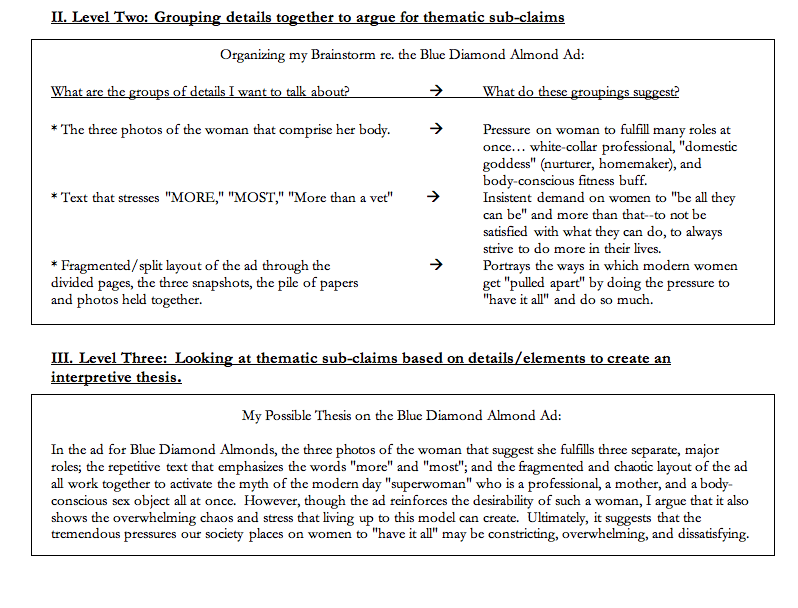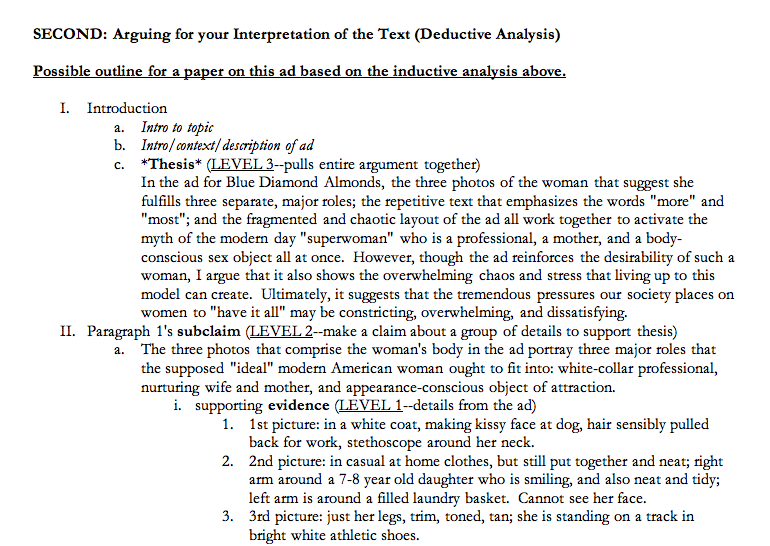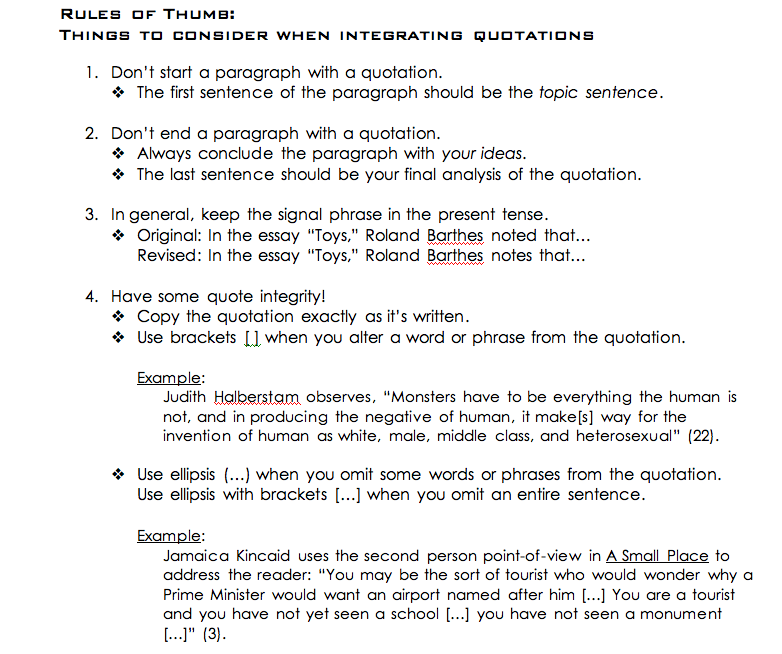DOC 1, 2 & 3 Course Objectives and Goals


Writing About Imaginative Texts - Week #1 Handout




Model of Inductive and Deductive Add Analysis
From Amber Carini's Site




Analyzing Poetry - Getting Started:



AnalyzingPoetry--GettingStarted.doc
Analyzing Short Stories - Getting Started:


AnalyzingShortStories--GettingStarted.doc
Context for LeGuin Piece




ContextforLeGuinfromGenesis.doc
USEFUL TERMS FOR ANALYZING THEATRE and POETRY
Allegory
A symbolic narrative in which the surface details imply a secondary meaning. Allegory often takes the form of a story in which the characters represent moral qualities. The most famous example in English is John Bunyan's Pilgrim's Progress, in which the name of the central character, Pilgrim, epitomizes the book's allegorical nature. Kay Boyle's story "Astronomer's Wife" and Christina Rossetti's poem "Up-Hill" both contain allegorical elements.
Ballad
A narrative poem written in four-line stanzas, characterized by swift action and narrated in a direct style. The Anonymous medieval ballad, "Barbara Allan," exemplifies the genre.
Blank verse
A line of poetry or prose in unrhymed iambic pentameter. Shakespeare's sonnets, Milton's epic poem Paradise Lost, and Robert Frost's meditative poems such as "Birches" include many lines of blank verse. Here are the opening blank verse lines of "Birches": When I see birches bend to left and right / Across the lines of straighter darker trees, / I like to think some boy's been swinging them.
Caesura
A strong pause within a line of verse.
Character
An imaginary person that inhabits a literary work. Literary characters may be major or minor, static (unchanging) or dynamic (capable of change). In Shakespeare's Othello, Desdemona is a major character, but one who is static, like the minor character Bianca. Othello is a major character who is dynamic, exhibiting an ability to change.
Climax
The turning point of the action in the plot of a play or story. The climax represents the point of greatest tension in the work. The climax of John Updike's "A&P," for example, occurs when Sammy quits his job as a cashier.
Complication
An intensification of the conflict in a story or play. Complication builds up, accumulates, and develops the primary or central conflict in a literary work. Frank O'Connor's story "Guests of the Nation" provides a striking example, as does Ralph Ellison's "Battle Royal."
Conflict
A struggle between opposing forces in a story or play, usually resolved by the end of the work. The conflict may occur within a character as well as between characters. Lady Gregory's one-act play The Rising of the Moon exemplifies both types of conflict as the Policeman wrestles with his conscience in an inner conflict and confronts an antagonist in the person of the ballad singer.
Connotation
The associations called up by a word that goes beyond its dictionary meaning. Poets, especially, tend to use words rich in connotation. Dylan Thomas's "Do Not Go Gentle into That Good Night" includes intensely connotative language, as in these lines: "Good men, the last wave by, crying how bright / Their frail deeds might have danced in a green bay, / Rage, rage against the dying of the light."
Convention
A customary feature of a literary work, such as the use of a chorus in Greek tragedy, the inclusion of an explicit moral in a fable, or the use of a particular rhyme scheme in a villanelle. Literary conventions are defining features of particular literary genres, such as novel, short story, ballad, sonnet, and play.
Denouement
The resolution of the plot of a literary work. The denouement of Hamlet takes place after the catastrophe, with the stage littered with corpses. During the denouement Fortinbras makes an entrance and a speech, and Horatio speaks his sweet lines in praise of Hamlet.
Dialogue
The conversation of characters in a literary work. In fiction, dialogue is typically enclosed within quotation marks. In plays, characters' speech is preceded by their names.
Diction
The selection of words in a literary work. A work's diction forms one of its centrally important literary elements, as writers use words to convey action, reveal character, imply attitudes, identify themes, and suggest values. We can speak of the diction particular to a character, as in Iago's and Desdemona's very different ways of speaking in Othello. We can also refer to a poet's diction as represented over the body of his or her work, as in Donne's or Hughes's diction.
That's my last Duchess painted on the wall,
Looking as if she were alive. I call
That piece a wonder, now....
Epic
A long narrative poem that records the adventures of a hero. Epics typically chronicle the origins of a civilization and embody its central values. Examples from western literature include Homer's Iliad and Odyssey, Virgil's Aeneid, and Milton's Paradise Lost.
Exposition
The first stage of a fictional or dramatic plot, in which necessary background information is provided. Ibsen's A Doll's House, for instance, begins with a conversation between the two central characters, a dialogue that fills the audience in on events that occurred before the action of the play begins, but which are important in the development of its plot.
Falling action
In the plot of a story or play, the action following the climax of the work that moves it towards its denouement or resolution. The falling action of Othello begins after Othello realizes that Iago is responsible for plotting against him by spurring him on to murder his wife, Desdemona.
Figurative language
A form of language use in which writers and speakers convey something other than the literal meaning of their words. Examples include hyperbole or exaggeration, litotes or understatement, simile and metaphor, which employ comparison, and synecdoche and metonymy, in which a part of a thing stands for the whole.
Flashback
An interruption of a work's chronology to describe or present an incident that occurred prior to the main time frame of a work's action. Writers use flashbacks to complicate the sense of chronology in the plot of their works and to convey the richness of the experience of human time. Faulkner's story "A Rose for Emily" includes flashbacks.
Foil
A character who contrasts and parallels the main character in a play or story. Laertes, in Hamlet, is a foil for the main character; in Othello, Emilia and Bianca are foils for Desdemona.
Foot
A metrical unit composed of stressed and unstressed syllables. For example, an iamb or iambic foot is represented by ˘', that is, an unaccented syllable followed by an accented one. Frost's line "Whose woods these are I think I know" contains four iambs, and is thus an iambic foot.
Foreshadowing
Hints of what is to come in the action of a play or a story. Ibsen's A Doll's House includes foreshadowing as does Synge's Riders to the Sea. So, too, do Poe's "Cask of Amontillado" and Chopin's "Story of an Hour."
Free verse
Poetry without a regular pattern of meter or rhyme. The verse is "free" in not being bound by earlier poetic conventions requiring poems to adhere to an explicit and identifiable meter and rhyme scheme in a form such as the sonnet or ballad. Modern and contemporary poets of the twentieth and twenty-first centuries often employ free verse. Williams's "This Is Just to Say" is one of many examples.
Imagery
The pattern of related comparative aspects of language, particularly of images, in a literary work. Imagery of light and darkness pervade James Joyce's stories "Araby," "The Boarding House," and "The Dead." So, too, does religious imagery.
Irony
A contrast or discrepancy between what is said and what is meant or between what happens and what is expected to happen in life and in literature. In verbal irony, characters say the opposite of what they mean. In irony of circumstance or situation, the opposite of what is expected occurs. In dramatic irony, a character speaks in ignorance of a situation or event known to the audience or to the other characters. Flannery O'Connor's short stories employ all these forms of irony, as does Poe's "Cask of Amontillado."
Lyric poem
A type of poem characterized by brevity, compression, and the expression of feeling. Most of the poems in this book are lyrics. The anonymous "Western Wind" epitomizes the genre:
Western wind, when will thou blow,
The small rain down can rain?
Christ, if my love were in my arms
And I in my bed again!
Metaphor
A comparison between essentially unlike things without an explicitly comparative word such as like or as. An example is "My love is a red, red rose,"
From Burns's "A Red, Red Rose." Langston Hughes's "Dream Deferred" is built entirely of metaphors. Metaphor is one of the most important of literary uses of language. Shakespeare employs a wide range of metaphor in his sonnets and his plays, often in such density and profusion that readers are kept busy analyzing and interpreting and unraveling them. Compare Simile.
Meter
The measured pattern of rhythmic accents in poems. See Foot and Iamb.
Narrator
The voice and implied speaker of a fictional work, to be distinguished from the actual living author. For example, the narrator of Joyce's "Araby" is not James Joyce himself, but a literary fictional character created expressly to tell the story. Faulkner's "A Rose for Emily" contains a communal narrator, identified only as "we." See Point of view.
Open form
A type of structure or form in poetry characterized by freedom from regularity and consistency in such elements as rhyme, line length, metrical pattern, and overall poetic structure. E.E. Cummings's "[Buffalo Bill's]" is one example. See also Free verse.
Parody
A humorous, mocking imitation of a literary work, sometimes sarcastic, but often playful and even respectful in its playful imitation. Examples include Bob McKenty's parody of Frost's "Dust of Snow" and Kenneth Koch's parody of Williams's "This is Just to Say."
Personification
The endowment of inanimate objects or abstract concepts with animate or living qualities. An example: "The yellow leaves flaunted their color gaily in the breeze." Wordsworth's "I wandered lonely as a cloud" includes personification.
Plot
The unified structure of incidents in a literary work. See Conflict, Climax, Denouement, andFlashback.
Point of view
The angle of vision from which a story is narrated. See Narrator. A work's point of view can be: first person, in which the narrator is a character or an observer, respectively; objective, in which the narrator knows or appears to know no more than the reader; omniscient, in which the narrator knows everything about the characters; and limited omniscient, which allows the narrator to know some things about the characters but not everything.
Protagonist
The main character of a literary work--Hamlet and Othello in the plays named after them, Gregor Samsa in Kafka's Metamorphosis, Paul in Lawrence's "Rocking-Horse Winner."
Quatrain
A four-line stanza in a poem, the first four lines and the second four lines in a Petrachan sonnet. A Shakespearean sonnet contains three quatrains followed by a couplet.
Recognition
The point at which a character understands his or her situation as it really is. Sophocles' Oedipus comes to this point near the end of Oedipus the King; Othello comes to a similar understanding of his situation in Act V of Othello.
Resolution
The sorting out or unraveling of a plot at the end of a play, novel, or story. See Plot.
Reversal
The point at which the action of the plot turns in an unexpected direction for the protagonist. Oedipus's and Othello's recognitions are also reversals. They learn what they did not expect to learn. See Recognition and also Irony.
Rhyme
The matching of final vowel or consonant sounds in two or more words. The following stanza of "Richard Cory" employs alternate rhyme, with the third line rhyming with the first and the fourth with the second:
Whenever Richard Cory went down town,
We people on the pavement looked at him;
He was a gentleman from sole to crown
Clean favored and imperially slim.
Rhythm
The recurrence of accent or stress in lines of verse. In the following lines from "Same in Blues" by Langston Hughes, the accented words and syllables are underlined:
I said to my baby,
Baby take it slow....
Lulu said to Leonard
I want a diamond ring
Rising action
A set of conflicts and crises that constitute the part of a play's or story's plot leading up to the climax. See Climax, Denouement, and Plot.
Setting
The time and place of a literary work that establish its context. The stories of Sandra Cisneros are set in the American southwest in the mid to late 20th century, those of James Joyce in Dublin, Ireland in the early 20th century.
Simile
A figure of speech involving a comparison between unlike things using like, as, or as though. An example: "My love is like a red, red rose."
Stanza
A division or unit of a poem that is repeated in the same form--either with similar or identical patterns or rhyme and meter, or with variations from one stanza to another. The stanzas of Gertrude Schnackenberg's "Signs" are regular; those of Rita Dove's "Canary" are irregular.
Style
The way an author chooses words, arranges them in sentences or in lines of dialogue or verse, and develops ideas and actions with description, imagery, and other literary techniques. See Connotation, Denotation, Diction, Figurative language, Image, Imagery, Irony, Metaphor, Narrator, Point of view, Syntax, and Tone.
Subject
What a story or play is about; to be distinguished from plot and theme. Faulkner's "A Rose for Emily" is about the decline of a particular way of life endemic to the American south before the civil war. Its plot concerns how Faulkner describes and organizes the actions of the story's characters. Its theme is the overall meaning Faulkner conveys.
Subplot
A subsidiary or subordinate or parallel plot in a play or story that coexists with the main plot. The story of Rosencrantz and Guildenstern forms a subplot with the overall plot of Hamlet.
Symbol
An object or action in a literary work that means more than itself, that stands for something beyond itself. The glass unicorn in The Glass Menagerie, the rocking horse in "The Rocking-Horse Winner," the road in Frost's "The Road Not Taken"--all are symbols in this sense.
Syntax
The grammatical order of words in a sentence or line of verse or dialogue. The organization of words and phrases and clauses in sentences of prose, verse, and dialogue.
Theme
The idea of a literary work abstracted from its details of language, character, and action, and cast in the form of a generalization. See discussion of Dickinson's "Crumbling is not an instant's Act."
Tone
The implied attitude of a writer toward the subject and characters of a work, as, for example, Flannery O'Connor's ironic tone in her "Good Country People." See Irony.
Understatement
A figure of speech in which a writer or speaker says less than what he or she means; the opposite of exaggeration. The last line of Frost's "Birches" illustrates this literary device: "One could do worse than be a swinger of birches."
--WRITING ABOUT MOVIES--


WritingAboutMovies.doc
Why A Movie Is Not Just A Movie




Whyamovieisnotjustamovie.pdf
Doing a Rhetorical Analysis of a Speech




Doing a Rhetorical Analysis of a Speech.doc
Film Form Handout




Film Form Handout.doc
Apocalypse Now
%201.png)
%202.png)
Apocalypse Now (Student vers.).doc
The Exciting World of Integrating Quotation






The Exciting World of Integrating Quotations.doc
Signal Verbs


signal verbs.doc
How many times has this page been viewed?

Comments (0)
You don't have permission to comment on this page.